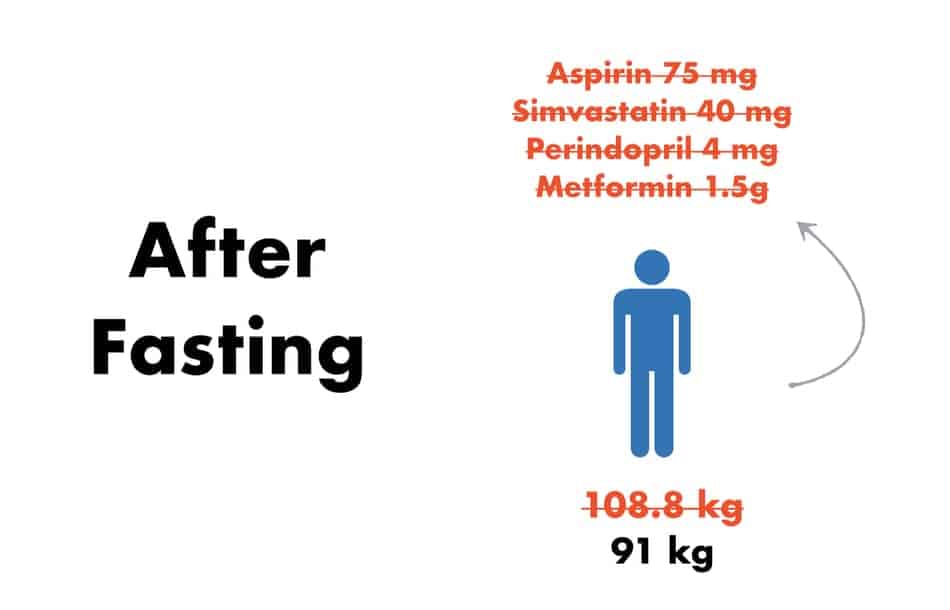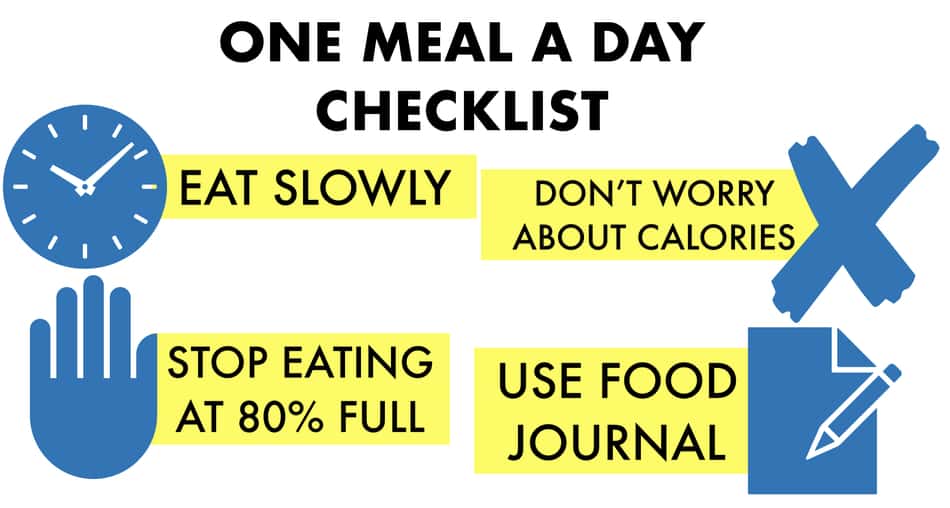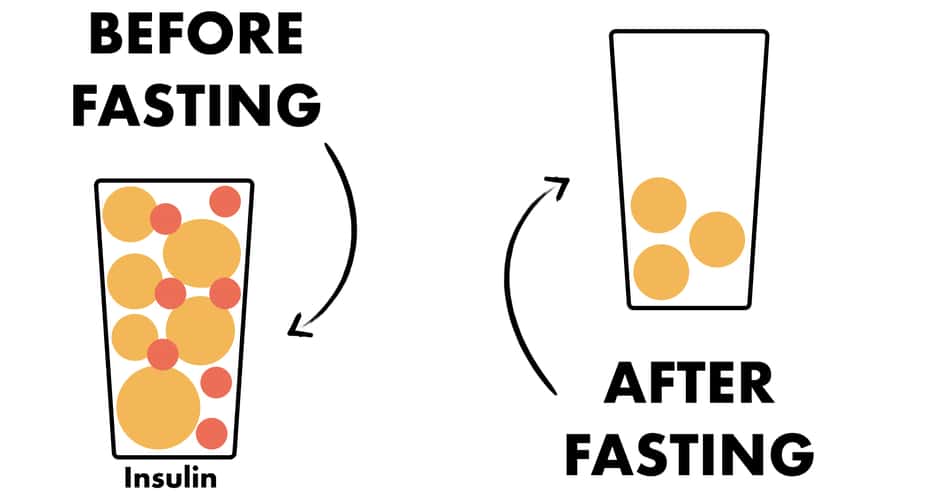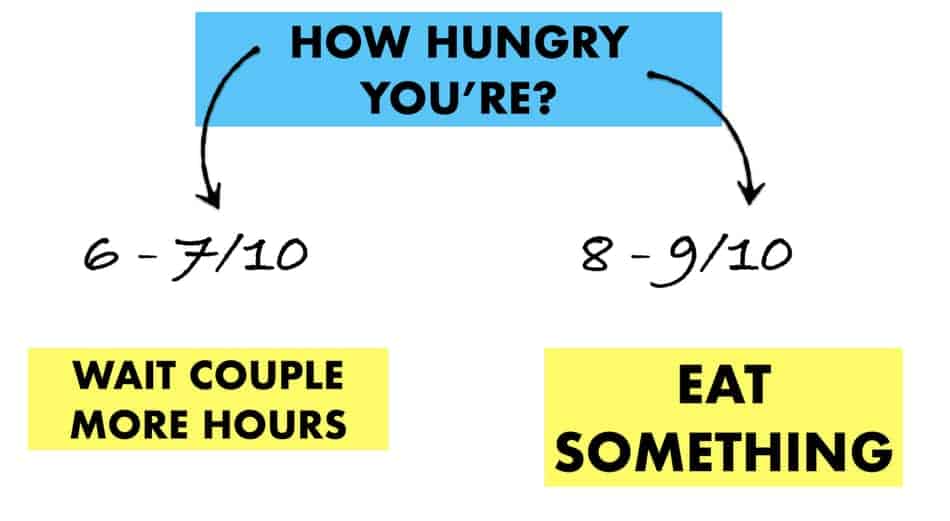
OMAD is providing great and broad benefits for health, weight loss, and longevity. Each month there is a new and promising body of research coming out and shreds new light and perspective on how intermittent fasting is beneficial in multiple angles.
In this article, I will provide an in-depth breakdown of each of the benefits that one meal a day delivers. And in case I’ve sparked your curiosity, some sections provide additional resources for your reading pleasure.
Here are the 20 OMAD benefits that are based on current research.
#1: Reduces Blood Pressure
OMAD is good for blood pressure because it alters gut microbiome. Studies have shown that intermittent fasting results in significant differences in microbial composition, which positively impacts cardiometabolic health and lowers both systolic and diastolic blood pressure.
A recent study done by Dr. András Maifeld from the Universitätsmedizin Berlin showed that intermittent fasting “alters the gut microbiome, impacting bacterial taxa and gene modules associated with short-chain fatty acid production.” (Maifeld, A., Bartolomaeus, H., Löber, U. et al. 2021)
5-day fasting, followed by DASH diet was enough not only to reduce blood pressure but also to reduce intake of antihypertensive medications.
Can OMAD cause high blood pressure? In general, OMAD does not cause high blood pressure. According to the most recent hypertension-related research, intermittent fasting helps to lower both systolic and diastolic blood pressure. The results vary, depending on the fasting protocol and duration.
#2: Helps with Weight Loss
OMAD is good for weight loss because it leads to a calorie deficit and fat oxidation. Reduced energy intake creates a negative energy balance where the body switches from using glucose as the main source of energy into using body fat.
Well-documented research done by fasting expert Françoise Wilhelmi de Toledo, the founder of the Medical Association for Fasting and Nutrition, shows that people who fasted 4 – 21 days observed a significant reduction in weight, abdominal circumference, and even blood pressure.
In her study, 1422 people participated in a fasting program between 4 and 21 days. Please be aware that daily caloric intake was 200–250 kcal, not zero.
84.4% of participants reported improved pre-existing health complaints. 93.2% of participants reported an increase in physical and emotional well-being and the absence of a hunger feeling. Less than 1% of participants experienced adverse effects (Wilhelmi de Toledo, Françoise et al. 2019 ).
#3: Helps with Diabetes
OMAD is good for people with diabetes because it reduces insulin resistance and improves insulin sensitivity. Insulin resistance is the main component of type 2 diabetes. Intermittent fasting helps to lower glucose levels by creating calorie restriction and lowering insulin levels.
Can OMAD cause diabetes? In general, OMAD doesn’t cause diabetes because it helps to utilize glucose levels more efficiently. This improves glucose clearance from the blood, muscle glucose uptake, and insulin sensitivity.

A great body of research has documented the effects of intermittent fasting not only on glucose levels but also on the reduction of anti-diabetic medications.
#4: Makes Food Taste Better
OMAD makes food taste better. Intermittent fasting stimulates nasal chemosensory, olfaction, and palatability. The longer you fast, the more sensitive your sensors become so you can smell and taste food more intensely.
This means, when you are not eating for most of the day, you will appreciate food so much more (Cameron, Jameason D et al. 2012).
For instance, remember when you last time walk through the food court in the mall on the empty stomach? Have you noticed how intense food can smell? You can smell it even from a far distance. Have you noticed how tempting even the food images look?
That’s because longer fast makes our senses more apparent. And once you eat, the food taste so much better? So why not use that in your favor.
#5: Good for Athletes
Generally, OMAD is good for athletes because it improves athletes’ performance and energy efficiency. Intermittent fasting also has been shown to favorably influence the brain plasticity and cognitive performance of athletes at rest.
Take a look at the study done by Dr. Xavier Capó from the University of Balearic Islands. He documented a group of twenty taekwondo practitioners and the effect of doing intermittent calorie restriction (30-40% of their regular food intake) on their performance (Capó, Xavier et al. 2020).
The results after one month of doing calorie restriction (every other day) showed that on average all participants lost 5.9% of body weight, decreased the expiratory volume, and downregulated the gene expression of antioxidant enzymes.
#6: Helps with Keto
In general, OMAD is good for any dietary approach, including the keto diet. Doing one meal a day helps to create and maintain ketosis. 8-12 hours after your last meal the body enters into ketosis where it starts using fat for energy.
Does OMAD cause ketosis? As a general rule, OMAD does cause ketosis because it allows for 23-hours of fasting window. During the absence of food, the body starts to adapt, and switches into breaking down fatty acids and produce acetyl-CoA. Build up of acetyl-CoA triggers the liver to stat ketone body formation.

Can you do OMAD and Keto? You can do OMAD on keto because it speeds up the process where the body switches from using glucose as the main energy source into using stored body fat. Doing OMAD can also help to create a calorie deficit that enhances weight loss.
#7: Better than ADF
As a general rule, OMAD is better than ADF because it allows to stay more consistent. People who struggle to do ADF (alternate day fasting), where you eat for 12 hours and fast for 36-hours, can do OMAD as a alternative because it allows to have one meal every day.
Personally, when I do intermittent fasting I prefer to eat something. Otherwise, I have difficulty in falling a sleep. It can be done, not it’s not sustainable.
#8: Helps with Fatty Liver
In general, OMAD is good for fatty liver because it reduces total calorie intake. When calorie intake surpasses calorie expenditure, the excess energy is then stored in the form of non-esterified fatty acids from visceral adipose tissue into an ectopic fat deposition in other organs, such as the liver.
Can skipping meals cause fatty liver? Skipping meals cannot cause fatty liver because it reduces the amount of calorie intake. Fatty liver is developed after excessive calorie consumption, and skipping meals helps to reduce total food intake.
Doing one meal a day significantly lowers the total energy consumption, which lowers the ectopic fat deposition. Have a look at the study done by Dr. Stefan Drinda from Switzerland on periodic fasting. Participants were eating 600 kcal per day for 6-32 days, which is equivalent to doing one meal a day.
The results showed that all participants lowered their FLI (fatty liver index). However, 120 of the 264 people shifted from the high-risk category (FLI ≥ 60) to the lower category of FLI risk after fasting (Drinda, Stefan et al. 2019).
#9: Helps with Fat Loss
OMAD is good for fat loss because it reduces total energy intake and triggers the metabolic switch. 8-12 hours after the last meals, the body stops predominately relying on glucose as the main energy source, and it’s switching to using the stored fat deposits
That is called metabolic flexibility. The body is switching from using one source of energy into another, based on the current availability. So if the food is not available, the body will start to utilize stored energy sources. As a result, we burn fat (Smith, Reuben L et al. 2018).

#10: Good for Muscle Gain
In general, OMAD is good for muscle gain, as long as you eat enough protein. Muscle gain is unrelated to calorie intake, and as long as adequate protein intake is maintained (1 g per pound of body weight) together with progressive overload, it will stimulate muscle protein synthesis and hypertrophy.
I won’t talk about exact mechanics of how does muscle gain works when you do intermittent fasting.
#11: Helps with Hypothyroidism
Generally, OMAD is good for hypothyroidism, as long as you have enough carbohydrates with your meal because carbs influence thyroid metabolism. During intermittent fasting the concentration on T3 slightly decrease, however, the serum reverse T3 levels increase.
Adding carbohydrates to the meal helps to control the concentration of T3. In a study done by Dr. Renato Pasquali from the University of Bologna, researchers documented that serum T3 concentration was significantly decreased at 40 to 50 g of carbohydrates per day, comparing to 105 g (Pasquali, R et al. 1982).
#12: Helps with Health
OMAD is good for health because it leads to several positive health outcomes like improved insulin sensitivity, lowered blood pressure, or reduced excess body weight. One meal a day diet also positively impacts the gastrointestinal tract and circadian rhythms.
Studies have shown that changes in the gut microbiota are related to net energy absorption, energy expenditure, and energy storage. Calorie restriction shifts intestinal microbial composition and have positive on metabolic health (Tilg, H., & Kaser, A. 2011).
#13: Good for IBS
In general, OMAD is good for IBS because it favorably shapes gut microbiota microorganisms. Restricting food intake for 12 to 24 hours helps to restore gut microbiota which plays a role in maintaining physiological homeostasis.
A study by Dr. Motoyori Kanazawa from the Tohoku University Graduate School of Medicine in Japan showed that 10 days of intermittent fasting significantly improved 7 out of the 10 symptoms like abdominal pain-discomfort, diarrhea, anorexia, and anxiety (Kanazawa, M., & Fukudo, S. 2006).
#14: Reduce Insulin Resistance
As a general rule, OMAD is good for insulin resistance because it reduces the overall food intake and improves glycemic control. With lower calorie intake, the body has to start utilizing fat for energy, which lowers insulin levels and helps to improve insulin sensitivity.
A recent study done by Dr. Elizabeth F. Sutton from Pennington Biomedical Research Center documented that intermittent fasting, even when done without calorie restriction, was enough to significantly improve glucose metabolism and insulin sensitivity (Sutton, Elizabeth F et al. 2013).

#15: Good for Immune System
OMAD is good for the immune system because it promotes hematopoietic stem cell activation and regeneration of immune cells. Studies have shown that intermittent fasting has positive changes in niche cells that promote stress resistance, self-renewal, and lineage-balanced regeneration.
Have a look at this compelling study done by Luigi Fontana, MD, Ph.D., the co-director of the Longevity Research Program at Washington University in St. Louis. He documented that prolonged fasting reduces pro-growth signaling and activates pathways that enhance cellular resistance to toxins and stress (Fontana, Luigi et al. 2010).
#16: Helps with Menopause
OMAD is good for menopause because it helps with some of the common health problems that women get after menopause. 80-85% of women experience unpleasant menopausal symptoms. Studies have shown that intermittent fasting helps to combat some of those issues.
Apart from metabolic health, fasting also positively impacts mental health. Some of the most common mental health problems include stress, moodiness, tension, anxiety, and emotional instability. Many studies documented the positive effects of fasting on dealing with mental health (Elavsky, S., & McAuley, E. 2007)
#17: Increase Hunger Tolerance
OMAD teaches you to differentiate physical hunger from emotional hunger. When you’re hungry on OMAD, do a self-assessment using a scale of 1 to 10. Asking yourself how hungry you’re on a scale of 1 to 10 will give you honest feedback.
This way you will be able to tell the difference between physical or psychological hunger. Sometimes we may feel like we are hungry, but in reality, we are just feeling something else. Maybe you feel a little bit bore, or even stressed out?
That’s when using self-assessment like scale 1-10 can really help to take an honest look and make an informed decision.

#18: Boost Metabolism
In general, OMAD is good for metabolism because it improves metabolic flexibility and the way body uses energy. One meal a day leads to frequent days of transitions between a fasting state to a fed state. This enhances the body’s ability to use whatever source of energy is currently available.
It also improves the way body metabolizes glucose and oxidizes fat. With prolonged calorie restriction, the body improves the efficiency of glucose being used. This leads to better body composition and lean body mass (Eshghinia, S. 2013).
#19: Helps with PCOS
OMAD is good for PCOS because it reduces the levels of IGF-1 (insulin growth factor-1), IGFBP1 (insulin-like growth factor-binding protein 1), glucose, and insulin. All those changes play a role in polycystic ovary syndrome and metabolic homeostasis.
I invite you to check out the very recent study done by Dr. Chunzhu Li from China Medical University in Liaoning. They have documented the effects of time intermittent fasting on eighteen PCOS women. The results showed significant improvements in menstruation, insulin resistance, and chronic inflammation (Li, Chunzhu et al. 2021).
#20: Stimulate Autophagy
Generally, OMAD does cause autophagy because calorie restriction slows down cellular senescence and recycles building blocks, allowing cells to adapt to stress. Fasting and energy restriction increases apoptosis and autophagy, potentially helping the cellular environment.
Cellular senescence is when cells stop growing, repairing, and release pro-inflammatory chemicals IL-6/IL-8. Think about this as cellular aging, which is inevitable. However, doing intermittent fasting slows down the rate at which cells age (Tajes, M et al. 2010).
Conclusion
Food is not scarce anymore. At least not in the western world. People still suffer from poverty in many parts of the world, but more diseases and health problems are due to obesity and overeating rather than starvation.
Doing OMAD meal a day can help to prevent a lot of health problems. Use that resource as information guide only.

This was a good read, thank you for posting this. I’m pre-diabetic and looking to prevent from becoming full blown diabetic. I’ll read the article you wrote/linked to about diabetes.
One more thing to add. I appreciate you linking to studies to back up your points.
Hey, Cindy! I’m glad you found this article helpful.
I was a diabetic patient before 3 years and 67 years old. I follow OMAD every day and monthly twice 36 hours dry fasting. Apart from every day 20,000 steps and 30 min indoor cycling. My diabetic has gone and no medication at all now. Eating one meal healthy diet only vegetarian.
But for everyone it is not easy to follow this up. My weight has come down from 108 kg to 80 kags. OMAD is very good and healthy life to live.